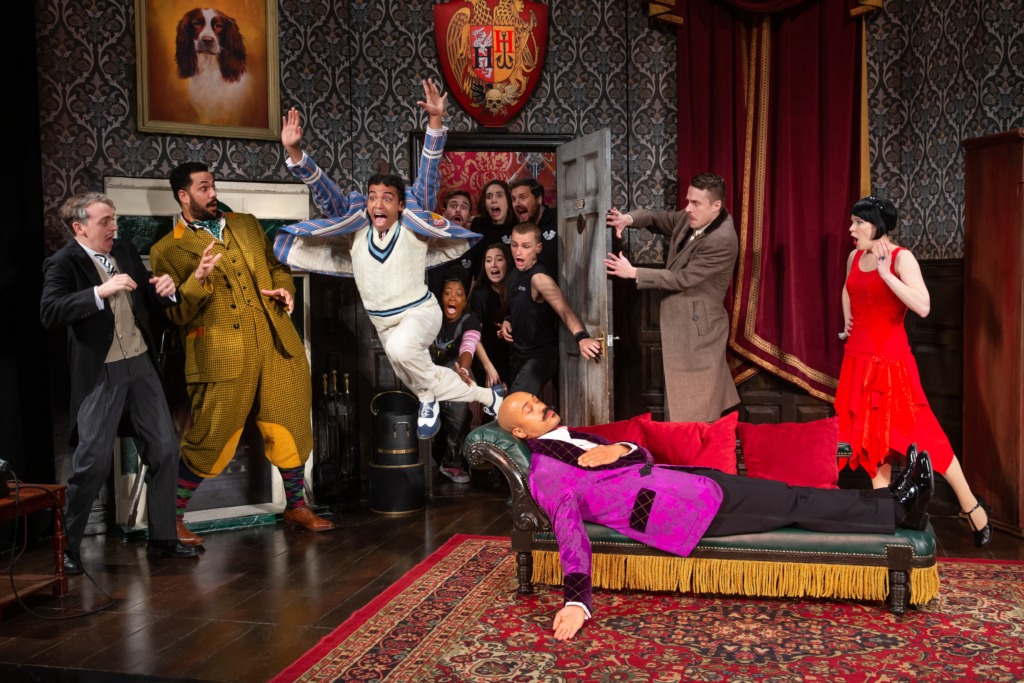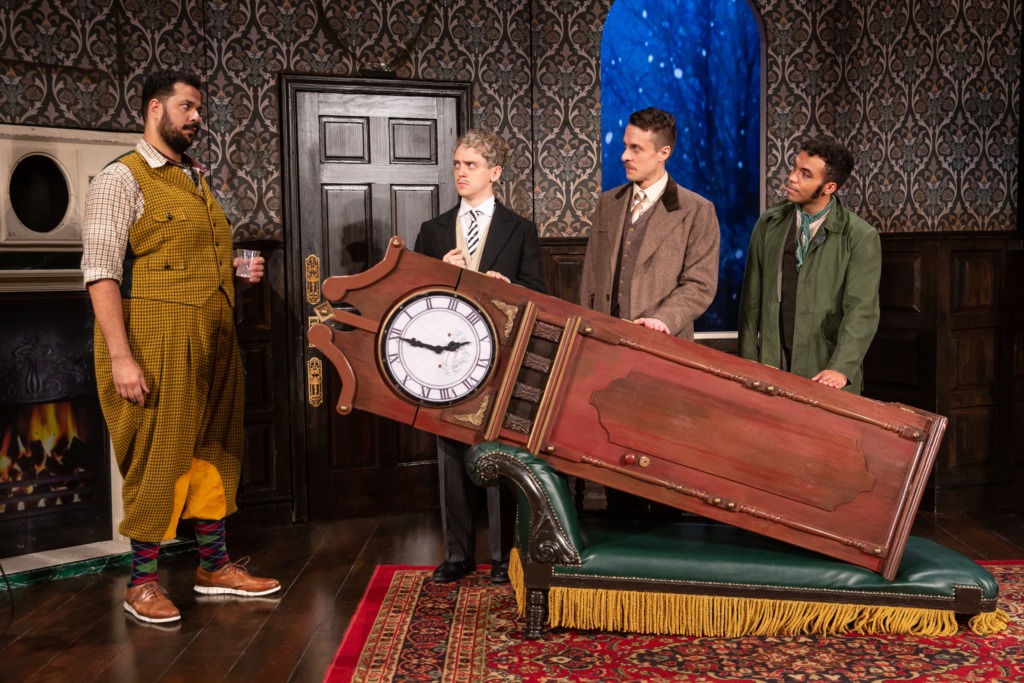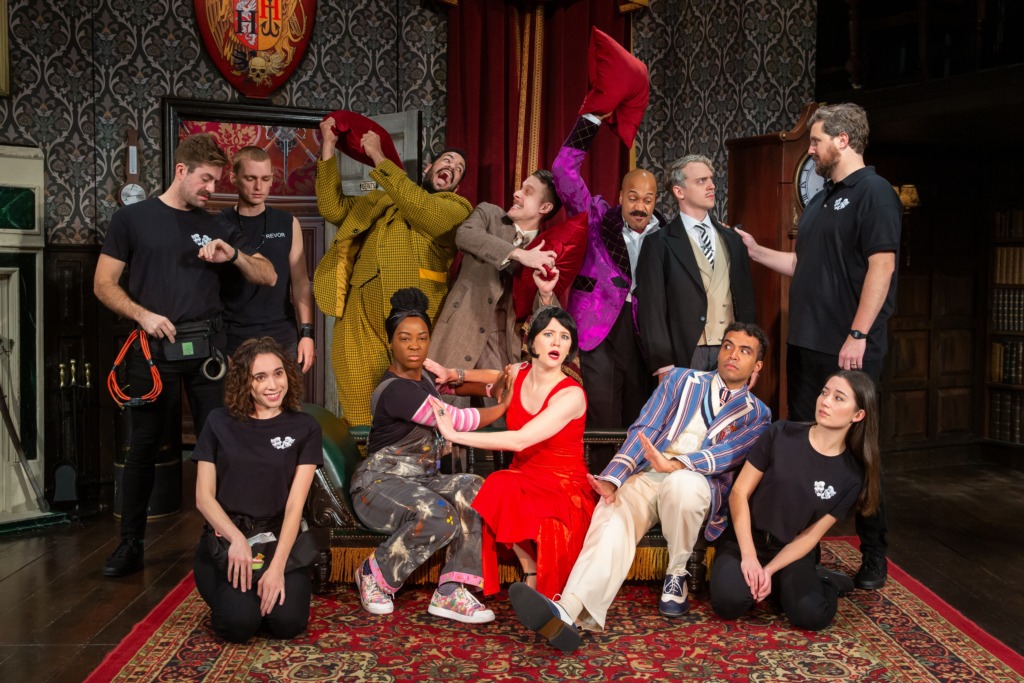“When going to see The Murder at Haversham Manor at the Kennedy Center, presented by the Cornley University Drama Society (as made possible by the British-American Cultural Exchange Program), I was expecting an elevated evening of mystery with fine acting and a dazzling script. I confess that I loved what I saw, though what I saw was perhaps not what the playwright had intended. To say that there was a misfortunate moment or two in the production would be putting it mildly, but one must give a mighty ‘Huzzah!’ to the indomitable cast who persevered long after any normal human being would have just given up and gone home.”- Dam. Judy Dench

Actually, of course, the play in question at the KC is The Play That Goes Wrong (Olivier Award for Best New Comedy and the Tony Award for Best Scenic Design) and most folks would agree that the “Goes Wrong” team have got humor very right. Created by Henry Lewis, Jonathan Sayer, and Henry Shields of the renowned Mischief Theatre, the play was inspired by Michael Green’s 1964 book The Art of Coarse Acting, and further influenced by the physical comedy of Buster Keaton, Charlie Chaplin and Mr. Bean.
At lights up, we’re welcomed by Chris Bean (Matt Harrington), president of the Cornley University Drama Society and director of the society’s murder-mystery, The Murder at Haversham Manor. Yet as the title suggests, everything that can possibly go wrong does go wrong, leading to a cascade of calamities that leaves the cast struggling to keep the show afloat in this farcical play-within-a-play.
The scenario is not unlike Michael Frayn’s hit farce ‘Noises Off’, which is also set in a theatre and shares the same theme of the gradual disintegration of theatre production, but Mischief Theatre owns this wholeheartedly in the play’s marketing, where it refers to it being a mix of ‘Noises Off’ and ‘Faulty Towers’. As in ‘Noises Off’, most of the actors play dual roles as a performer, and as their character in the mystery play. Yet “Wrong” isn’t interested in the relationship between its characters and the ones they portray in the play-within-a-play. It’s more lowbrow, interested in the gag and shameless in how it gets it: sometimes incredibly inventively, but sometimes going for the obvious and easy. Yet the parade of sight gags, slow burns, pratfalls, missed cues, wink-winks and the like overwhelm most viewer’s senses and cause even the most sophisticated spectators to laugh, despite themselves.

Even as the audience members take their seats, there is already an amusing sketch taking place with a hapless stage manager (a very funny Kai Heath) and a disgruntled sound operator (amusingly played by Akron Wilson) trying desperately to fix a collapsing mantelpiece before the show begins. Nigel Hook’s set has cleverly created the manor house’s slightly shabby oak-paneled drawing room complete with a green leather chaise longue, thick red velvet curtains, a grandfather clock and a mezzanine library which provides a fitting backdrop for the ensuing chaos. Roberto Surace’s 1920’s costumes are a perfect fit. A special nod goes to sound designer Andrew Johnson who created the various bonks, splats, and crashes.
The cast manages to make everything seem fresh, an incredibly difficult feat: perhaps one of the most difficult feats in an actor’s repertoire. Everyone has their moments, but perhaps the standouts are Alex Mandell as Max, who consistently breaks the fourth wall to receive/entice adulation from the audience, and Matt Harrington’s Chris, whose “walking down the stairs” bit and audience interactions were truly memorable in the onslaught of gags. Yet everyone scores: Mara Davi as Sandra, whether sensuously posing or catfighting; Peyton Crim’s Robert, trapped in that study; Bartley Booz’s Dennis, squinting and finally remembering his lines; Kai Heath’s Annie progressing from techie to diva; Joseph Anthony Byrd’s Jonathan’s trademark exit, and Akron Watson’s dance moves. They’re all delicious, and exhausting.

This tour production, directed by Matt DiCarlo (from the original Broadway direction by Mark Bell), is machine-like. The breakneck staging is a logistical miracle, but the characterizations lack the human vitality that might make it all truly magical. Not everything in the script or onstage works – and, quite frankly, two acts of physical farce may, at times, seem painfully repetitive and tiresome. There’s certainly no obedience to the comedic rule of three—that after 3 repetitions, a gag ceases to be funny—in fact, the production smashes it: how many times are we going to repeat that shtick, and how many times will the audience still laugh?
So as much as I kept laughing, the delight became something of a chore as the antics stretched on to the point that the mystery of the whodunit became a tiresome afterthought. Yet laugh we did and would recommend it to anyone who can keep their critical minds switched off, and lose themselves in breakneck, slapstick farce.
Arrive early and grab your seats as the pre-show starts immediately and should not be missed. Kick back, relax and just enjoy this extremely well-done farce with a truly stellar cast!
Running Time: Approximately 2 hours and 40 minutes with one intermission
The Play That Goes Wrong plays through August 13th 2023 in the Eisenhower Theatre at The John F. Kennedy Center for the Performing Arts, 2700 F Street NW, Washington, DC. For tickets call the box office at (202) 467-4600 or purchase them online.




